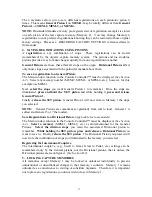
2
For more than sixty years--practically the entire history of electronic organs-- Allen Organ
Company has built the finest organs that technology would allow.
In 1939, Allen built and marketed the world’s first electronic oscillator organ. The tone
generators for this instrument used two hundred forty-four vacuum tubes, contained about
five thousand components, and weighed nearly three hundred pounds. Even with all this
equipment, the specification included relatively few stops.
By 1959, Allen had replaced vacuum tubes in oscillator organs with transistors. Thousands
of transistorized instruments were built, including some of the largest, most sophisticated
oscillator organs ever designed.
Only a radical technological breakthrough could improve upon the performance of Allen’s
oscillator organs. Such a breakthrough came in conjunction with the United States Space
Program in the form of highly advanced digital microcircuits. In 1971, Allen produced and
sold the world’s first musical instrument utilizing digitally sampled voices!
Your organ is significantly advanced since the first generation Allen digital instrument.
Organs with Renaissance
technology are the product of years of advancements in digital
sound and control techniques by Allen Organ Company. This system represents the apex of
digital technology applied to exacting musical tasks. The result is a musical instrument of
remarkably advanced tone quality and performance.
Congratulations
on the purchase of your new Allen Organ! You have acquired the most
advanced electronic organ ever built, one that harnesses a sophisticated custom computer
system to create and control beautiful organ sound. Familiarize yourself with the instrument
by reading through this booklet.
Contents
I.
Description of Stops .......................................................................................................3
II.
Tremulants......................................................................................................................4
III.
Expression Pedal ............................................................................................................4
IV.
Capture Combination Action..........................................................................................4
V.
Transposer ......................................................................................................................5
VI.
Artistic Registrations ......................................................................................................5
VII.
Virtual Acoustics™ ........................................................................................................7
VIII.
Installation, Voicing and Care of the Organ...................................................................7
IX.
Safety Instructions ..........................................................................................................9
X.
MIDI Guide ..................................................................................................................10
XI.
Console Controller Guide.............................................................................................15



































